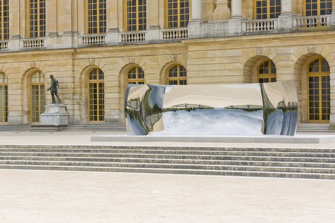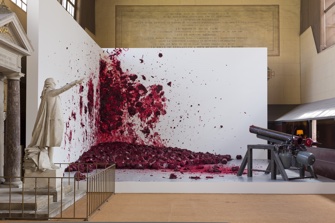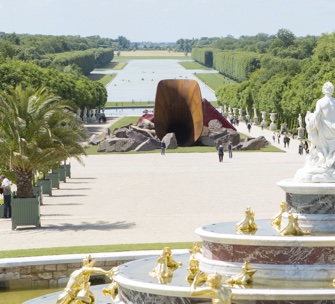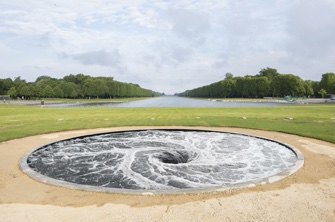Revolutionary Art Creates
Scandal at Versailles

“C-Curve” (2007). Photo: Tadzio. © Anish Kapoor 2015
The Bombay-born, London-based sculptor Sir Anish Kapoor succeeded in ruffling feathers at the opening of his summer exhibition in the Château de Versailles gardens. Conservative commentators and some local dignitaries objected to one of his installations, a giant horn-like structure rearing above the central axis of the formal gardens designed by André Le Nôtre for Louis XIV. Called “Dirty Corner,” the work was fiercely criticized as a desecration of France’s national heritage and was briefly defaced by vandals, who splattered it with yellow paint. Sir Anish hit back, calling his detractors far-right extremist terrorists.
Now that the commotion has subsided, this is a good time to judge the show for yourself.
Kapoor is the eighth contemporary artist to be offered a solo summer show at Versailles, following in the footsteps of, among others, the Japanese artist Takashi Murakami, the American Jeff Koons and the Portuguese Joana Vasconcelos.
Chosen to show at a historic moment – three hundred years after the death of Louis XIV – Kapoor has been the only artist to include an overtly political element in his exhibition. One work was installed in the Jeu de Paume, just outside the palace grounds, where a pledge to democracy sworn by the National Assembly in June 1789 ushered in the French Revolution. His installation “Shooting into the Corner,” echoing a painting on a back wall that commemorates the event, consists of a large paintball cannon surrounded by scattered piles

“Shooting into the Corner” (2008-09). Photo: Tadzio. © Anish Kapoor 2015
of wax rubble splattered in dark red paint (Kapoor’s signature color) simulating blood and devastation. Even Kapoor described this as a mess. An example of this work was shown at the Royal Academy of Arts in London in 2009.
Five other monumental works stand on the palace grounds. Only one entirely new piece was created for the occasion. Hidden in a bosquet (copse), it is called “Sectional Body Preparing for Monadic Singularity” (whatever that might mean). What you can actually see, and can even enter, is a hollow house-sized cube with various interlinked orifices revealing the sky.
The other four artworks have all been repurposed from earlier shows, though their new context arguably endows them with fresh meaning. Nearest the palace, set on the terrace leading to the gardens, is a semicircular strip of shining mirror, Kapoor’s favorite material. Titled “C-Curve” (pictured at the top of this page), it works like a fairground distorting mirror – one side turns reflected humans upside down and the other makes them taller, properties that have turned it into a perfect selfie photo opportunity for flocking visitors.
Next in line is “Sky Mirror,” standing like a giant satellite dish at the head of the stairway leading from the terrace to the garden. Tilted toward the sky, it prettily reflects the ever-changing scenery of sun and clouds.
Following in the same central axis on Le Nôtre’s grassy parterre sprawls the controversial piece mentioned above, “Dirty

“Dirty Corner” (2011-15). Photo: © Fabrice Seixas. © Anish Kapoor 2015
Corner.” Robin Lane Fox, gardening editor of the Financial Times, described the work as a “monstrous metal trumpet … backed by a rusty-colored drainpipe and flanked by huge piles of earth and rocks and red plastic blocks.” In fact, the site looks as if it has undergone a minor earthquake.
Beyond this lies a work called “Descension,”

“Descension” (2014). Photo: Fabrice Seixas. © Anish Kapoor 2015
featuring a newly dug circular whirlpool pond that exudes a hideous tsunami-like grinding noise as its black water swirls endlessly into a seemingly bottomless vortex – quite a surprise in this normally tranquil garden.
Anish Kapoor has an illustrious CV behind him. Winner of the Duemila Prize for best young artist at the 1990 Venice Biennale and the British Turner Prize in 1991, he is best known recently as the creator of “Leviathan,” a monumental sculpture shown at the Grand Palais in Paris in 2011, and the generally unloved ArcelorMittal Orbit viewing tower (variously described by critics as the “Godzilla of public art” and “Meccano on crack”) in London, built for the 2012 summer Olympic Games.
In spite of the rumpus in Versailles, Sir Anish will be back in France again this autumn, this time in Lyon, where his work will be shown in Saint-Marie de la Tourette, a 1950s Dominican convent designed by Le Corbusier, as part of the 13th Lyon Biennale.
The Versailles garden exhibition is free and runs till November 1.
Reader reaction: Click here to respond to this article (your response may be published on this page and is subject to editing).
Please support Paris Update by ordering books from Paris Update’s Amazon store at no extra cost. Click on your preferred Amazon location: U.K., France, U.S.
More reviews of Paris art shows.
© 2015 Paris Update
Favorite